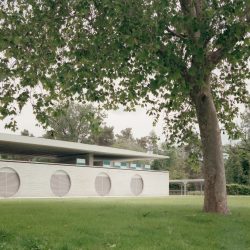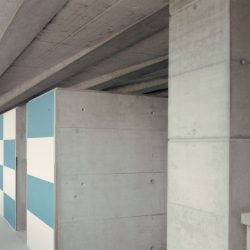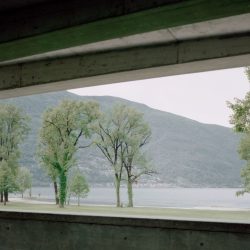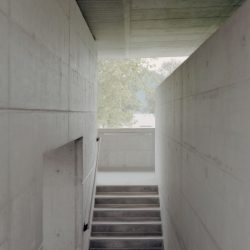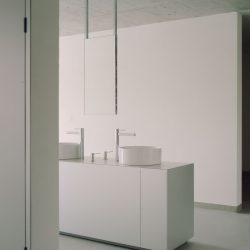
The project involved the simple internal conservative renovation of the spaces that were now dated, but above all ruined over the years, and the cleaning of the external spaces no longer suited to the objectives of the client, of the patrician Lido of Ascona, an important work by Livio Vacchini.
The renovation of the patricial Lido of Ascona goes from a large-scale look regarding the reorganization of some elements in the external space of the park, up to an architectural renovation regarding the main building and its interiors.
The old outdoor cabins play a key role in the park’s spatial feel. Arranged diagonally with respect to the main building, they acted as a visual shield between the lido building and the area of reeds, located to the east of the bottom, so their demolition allowed the visual horizon to be opened up, thus leaving a more visible view. complete throughout the park to users who are preparing to find a place on the lawn. This is a very important factor, if we consider the conceptual importance of the building, which appears as a filter between the built urban area and the nature of the lake.
Another demolition issue, in addition to the 20 cabins just mentioned, are all the terraces that have arisen over the years in the immediate vicinity of the main building. Elements of total disorder have suffocated and disrespectfully damaged the main building. These structures, including the foundation on which they rest, were removed in such a way as to bring the lawn back to the perimeter of the building, precisely up to the perimeter walkway. In this way it was possible to clean up and give space to the primordial project designed by L. Vacchini in 1986. This structure was in fact conceived as a filter between the urban and the nature of the park with the lake shore. A building characterized by a plinth, main volume, an intermediate floor and its ribbed roof. For this reason, in order to avoid a denaturalization of the original composition, nothing sticks to the building anymore. Everything, including the internal furnishings (hand basins), are separate elements, which allow the intervention phases to be clearly read, considering the changed needs compared to those of the 1980s. The most intense part from the point of view of the renovation, i.e. the main building, its entrance from the car park and the part of the outdoor area facing the lake, have been studied, also at a technical level, so as not to compromise the architectural substance yet recoverable. The access, both vehicular and pedestrian, has been maintained, like most of the internal functions and openings, so as to keep the original primary structure unchanged without altering its general appearance.
Entering from the car park, the first element we encounter are the two crescents with their bases. These have been slightly revised and repaired with small interventions aimed solely at cleaning them. The two internal rooms, at the time used as boxes for tennis and the beach, since they were no longer suited to today’s needs, have been used as storage and offices.
The front strip of the main building has been cleaned. Low vegetation, bushes, wheat or similar were added to the gravel surface, and unnecessary nets were removed so as to enhance the image of the Lido.
Entering the building and starting from the first floor, there were repainting works, arrangement of the 40 cabins with a new locking system, and the creation of a closed warehouse accessible only by management. As well as a central space open in its entirety. The warehouse to the east has been used as a technical room for boilers, heat pumps and electrical panels, since the entire building is located below the safety level inherent to the flooding of Lake Maggiore. The central space, unfortunately, is the result of a careless demolition that took place years ago for which we preferred not to aggravate the situation and leave the space as found since it can now be used for events or similar, therefore it will certainly bring more people to the interior of the building, making it appreciated as a diaphragm between the urban and natural context.
On the ground floor there was a major renovation project, aimed in particular at bringing the sanitary and electrical systems up to standard which, being old, no longer allowed them to fulfill their functions, both practical and regulatory. The ground floor has been divided into 5 distinct areas as follows: 1- management area and staff and disabled changing rooms; 2- men’s toilet area and 1st stairwell; 3- access area with new cash desk and kiosk; 4- women’s toilet area and 2nd stairwell; 5- kitchen with free service. Starting in order we find area n.1, where the office, the technical room (drinking water inlet), an external storage room, the changing room for the bathroom with shower and toilet and two separate showers, changing rooms and toilet for disabled people. In the second area as well as the fourth there are toilets, showers and changing rooms with lockers for women and men. These rooms have been completely renovated and cleaned. Maintaining the location of showers, toilets and benches, while everything else has undergone a planimetric modification aimed at improving the flows and the quality of the spaces themselves. Thanks to a central island distribution, the two sinks have become 8 without affecting the built structure. The systems, walls, floors, bathroom fixtures etc. they have been renovated while keeping the original project unchanged as much as possible. To keep the structure designed by the architect intact. L. Vacchini, the reinforced concrete walls have been entirely preserved. However, and unfortunately, the only area that was completely unchanged was the corridor of the bathrooms for disabled people and the area of the cabins on the first floor, since all the other areas in different sizes were no longer totally recoverable. Let’s think for example of the reinforced concrete walls that have been dispersion painted, the partitions and cabins demolished, the countless holes and measures made over the years. In the central area, the access area, it was simply used and prepared for the ticket office and a kiosk so as to limit the number of staff assigned to it. This area was then left entirely free and for the use of future management.
The last area, n.5, is that of the kitchen which has been completely renovated with changes to the plan and equipment in relation to simple use such as self-service. This part of the renovation saw the entire space brought up to standard and allowed the refreshment area to be located externally, to the side of the building and no longer at the front. This programmatic part, decided together with the client, has the ultimate objective of avoiding the regeneration of false structures applied to the main building, as has unfortunately happened in the last 15 years. From this perspective, we (client and designer) managed to turn the lido back into a bathing place mainly dedicated to sport and gastronomy and no longer an open-air disco. This theme, the program and the management intentions are and will be of vital importance for the preservation of Vacchini’s work in a qualitative state compliant with its historical-cultural value.
_
Il progetto ha previsto il semplice risanamento conservativo interno degli spazi ormai datati, ma soprattutto rovinati negli anni, e la pulizia degli spazi esterni ora non più confacenti con gli obbiettivi della committenza, del Lido patriziale di Ascona, importante opera di Livio Vacchini. La ristrutturazione del Lido patriziale di Ascona passa da uno sguardo a grande scala riguardante il riordino di alcuni elementi nello spazio esterno del parco, fino ad arrivare ad una ristrutturazione di tipo architettonico per quanto riguarda l’edificio principale e i suoi interni. Le vecchie cabine esterne giocano un ruolo chiave nella sensazione spaziale del parco. Disposte diagonalmente rispetto all’edificio principale, si comportavano come una schermatura visiva tra l’edificio del lido e la zona dei canneti, posta ad Est del fondo, per cui la loro demolizione ha permesso di aprire l’orizzonte visivo lasciando così uno sguardo più completo su tutto il parco all’utenza che si appresta a trovare posto sul prato. Questo è un fattore molto importante, se si considera l’importanza concettuale dell’edificio, il quale risulta come un filtro tra l’urbano costruito e la natura del lago. Altro tema di demolizione, oltre alle 20 cabine appena citate, sono tutte le terrazze sorte negli anni nell’immediata adiacenza dell’edificio principale. Elementi di totale disordine hanno soffocato e danneggiato irrispettosamente l’edificio principale. Queste strutture, compresa la platea sulle quali poggiano, sono state rimosse in modo tale da riportare il prato fino al perimetro della costruzione, con precisione sino al camminamento perimetrale. In questo modo si è potuto ripulire e lasciare respiro al progetto primordiale progettato da L. Vacchini nel 1986. Questa struttura era infatti pensata quale filtro tra l’urbano e la natura del parco con la riva del lago. Un edificio caratterizzato da uno zoccolo, volume principale, un piano intermedio e il suo tetto nervato. Per questo motivo, onde evitare una snaturalizzazione della composizione originale, nulla si attacca più all’edificio. Tutto, compresi gli arredi interni (lavamani) sono elementi separati, i quali permettono di leggere chiaramente le fasi di intervento, considerando le mutate esigenze rispetto a quelle degli anni ’80 dello scorso secolo. La parte più intensa dal punto di vista della ristrutturazione, ovvero l’edificio principale, la sua entrata dal parcheggio e la parte di dehor rivolta verso il lago, sono state studiate, anche a livello tecnico, in modo da non compromettere la sostanza architettonica ancora recuperabile. L’accesso, carrabile e pedonale, è stato mantenuto, come gran parte delle funzioni interne e delle aperture, così da mantenere invariata la struttura primaria originale senza alterarne l’aspetto generale. Entrando dal parcheggio come primo elemento incontriamo le due mezzelune con i loro basamenti. Queste sono state leggermente riviste e riparate con piccoli interventi mirati unicamente alla pulizia delle stess. I due locali interni, ai tempi utilizzati quali casse per il tennis e il lido, giacché non più confacenti alle odierne necessità, sono stati adibiti a deposito e ad uffici. La fascia frontale all’edificio principale è stata ripulita. Alla superfice in ghiaia si è aggiunta della vegetazione bassa, cespugli, grano o simili, e rimossa la ramina non necessaria così da valorizzare l’immagine del Lido. Entrando nell’edificio e partendo dal primo piano vi sono stati lavori di ritinteggio, sistemazione delle 40 cabine con un nuovo sistema di chiusura, la creazione di un deposito chiuso ed accessibile unicamente dalla gerenza. Oltre che ad uno spazio centrale aperto nella sua totalità. Il deposito ad Est è stato adibito a locale tecnico per bollitori, termopompa e quadri elettrici, giacché tutto l’edificio si trova al di sotto della quota di sicurezza inerente all’esondazione del Lago Maggiore. Lo spazio centrale, purtroppo è il risultato di un’incauta demolizione avvenuta anni addietro per la quale abbiamo preferito non aggravare la situazione e lasciare lo spazio come trovato giacché lo stesso ora potrà essere adoperato per eventi o simili, quindi porterà sicuramente più persona all’interno dell’edificio, facendolo apprezzare quale diaframma tra contesto urbano e naturale. Al piano terreno vi è stato un grande intervento di ristrutturazione, mirato in particolar modo alla messa a norma degli impianti sanitari ed elettrici i quali essendo vetusti non permettevano più di ottemperare alle loro funzioni, sia pratiche che normative. Il piano terra è stato suddiviso in 5 zone distinte come di seguito: 1- area gerenza e spogliatoi personale e disabili; 2- area wc uomini e 1° vano scale; 3- area di accesso con nuova cassa e chiosco; 4- area wc donne e 2° vano scala; 5- cucina con libero servizio. Partendo per ordine troviamo l’area n.1, dove sono stati collocati l’ufficio, il locale tecnico (entrata acqua potabile), un deposito esterno, lo spogliatoio per il personale con doccia e wc e in maniera separata due docce, spogliatoi e wc per disabili. Nella seconda zona come pure la quarta vi sono i servizi, le docce e gli spogliatoi con armadietti per donne e uomini. Questi locali sono stati integralmente ristrutturati e ripuliti. Mantenendo l’ubicazione di docce, wc e panchine, mentre tutto il resto ha subito una modifica planimetrica atta a migliorarne i flussi e la qualità degli spazi stessi. Grazie ad una distribuzione centrale ad isola i due lavandini sono diventati 8 e senza intaccare la struttura costruita. Gli impianti, le pareti, i pavimenti, i sanitari etc. sono stati rinnovati mantenendo il più possibile invariato il progetto originario. Per mantenere intatta la struttura progettata dall’arch. L. Vacchini, le pareti in cemento armato sono state integralmente conservate. Tuttavia, e purtroppo, la sola area che risultava integralmente invariata era il corridoio dei bagni per disabili e l’area delle cabine al primo piano, poiché tutte le altre aree in misure differenti non erano più totalmente recuperabili. Pensiamo per esempio alle pareti in CA che sono state pitturate a dispersione, i setti e le cabine demolite, gli innumerevoli fori e accorgimenti fatti negli anni. Nella zona centrale, quella dell’accesso, è stata semplicemente adibita e predisposta per la biglietteria e un chiosco cosi da limitare numero di personale ad esso adibito. Quest’area è poi stata lasciata interamente libera e ad usufrutto della futura gerenza. L’ultima area, la n.5, è quella della cucina la quale è stata rinnovata completamente con modifiche planimetriche e di attrezzature in rapporto ad un utilizzo semplice quale self-service. Questa parte di ristrutturazione ha visto la messa a norma di tutto lo spazio e ha permesso di ubicare l’area di ristoro esternamente, a lato dell’edificio e non più frontale. Questa parte programmatica, decisa assieme alla committenza, ha come obbiettivo ultimo di evitare la rigenerazione di strutture posticce applicate all’edificio principale, come purtroppo avvenuto negli ultimi 15 anni. In quest’ottica siamo riusciti (cliente e progettista) a far tornare il lido un luogo di balneazione principalmente dedita allo sport e alla gastronomia e non più una discoteca all’aperto. Questo tema, il programma e gli intenti gestionali, sono e saranno di vitale importanza per la preservazione dell’opera di Vacchini in uno stato qualitativo conforme al suo valore storico-culturale.

